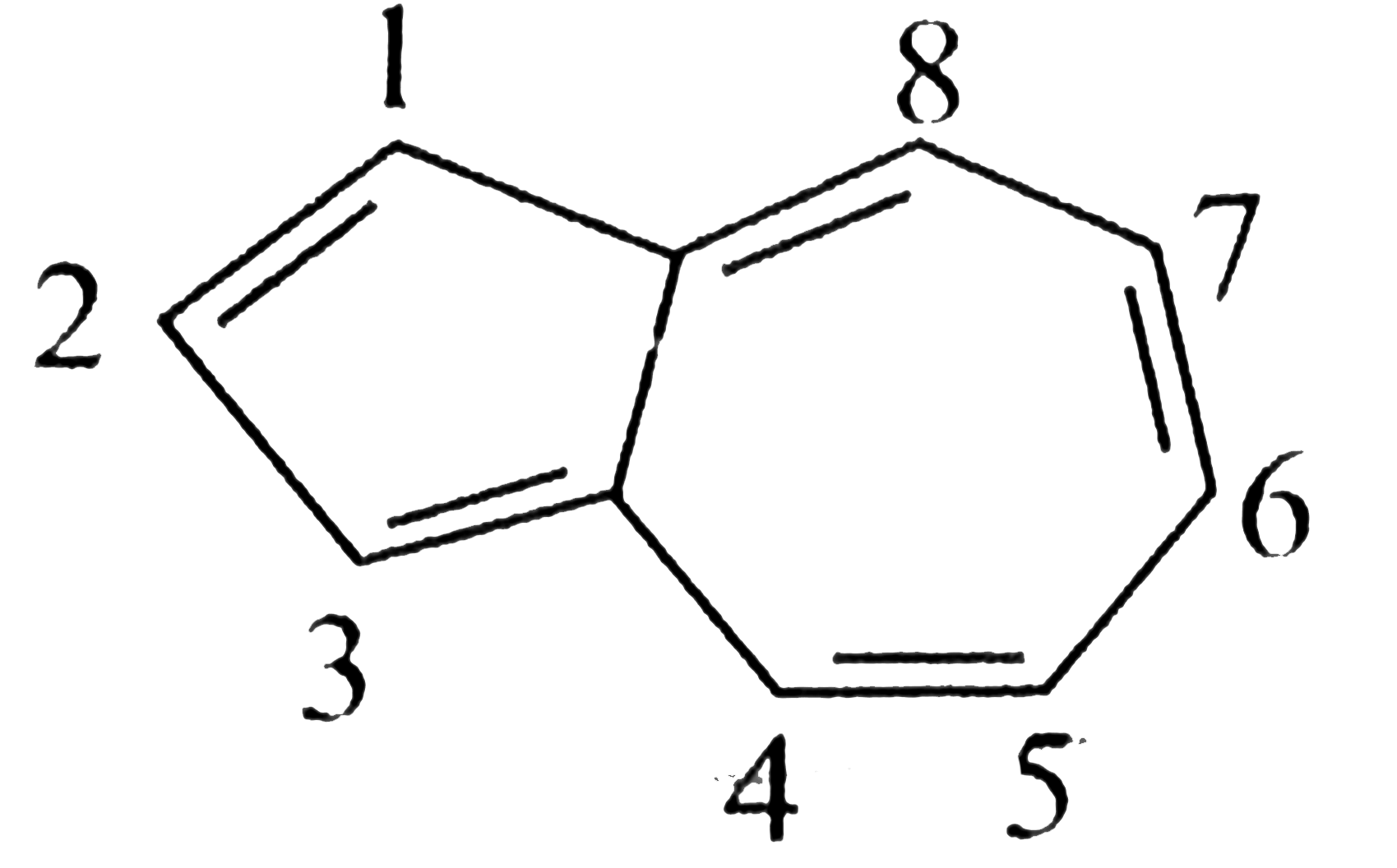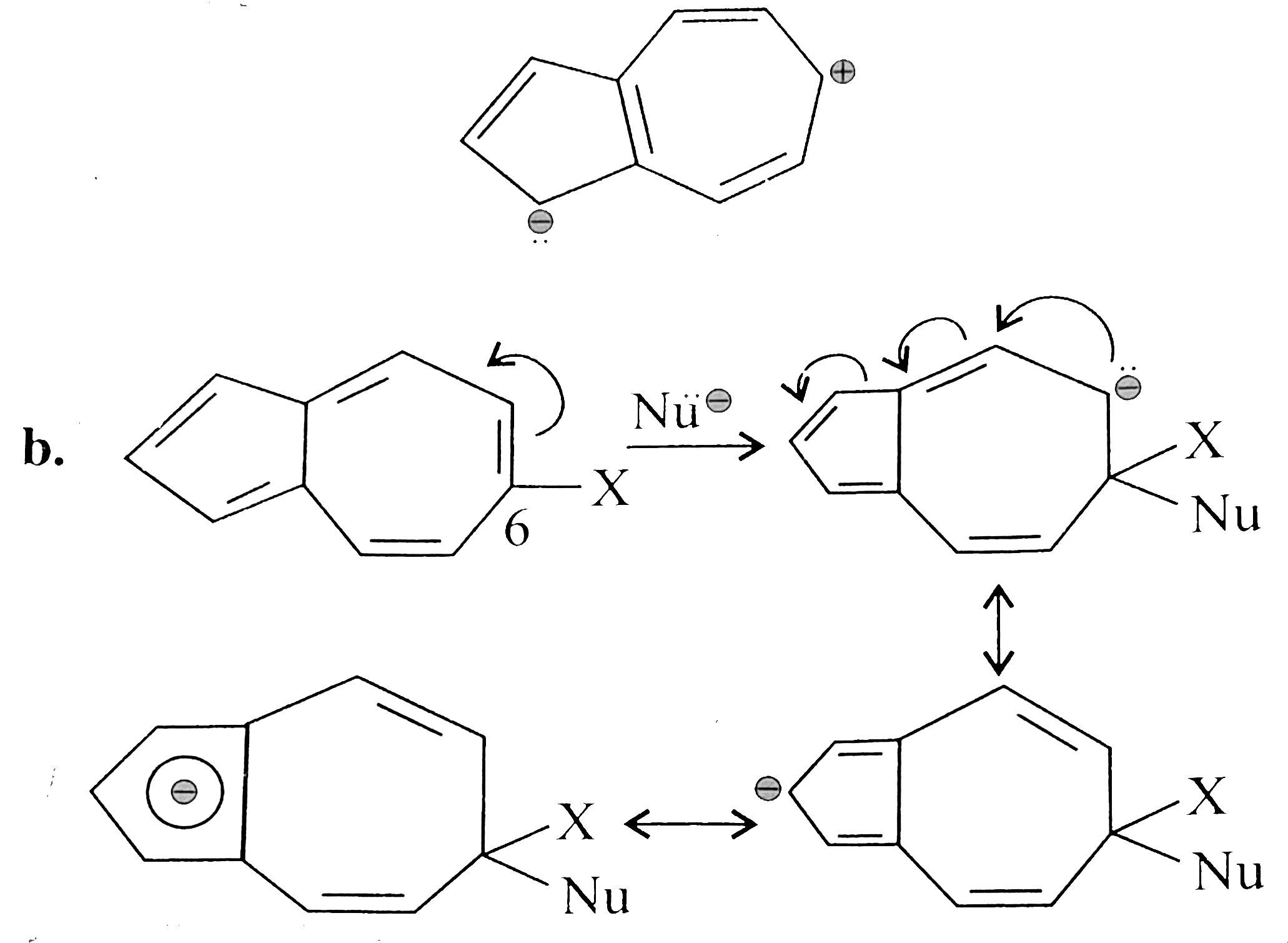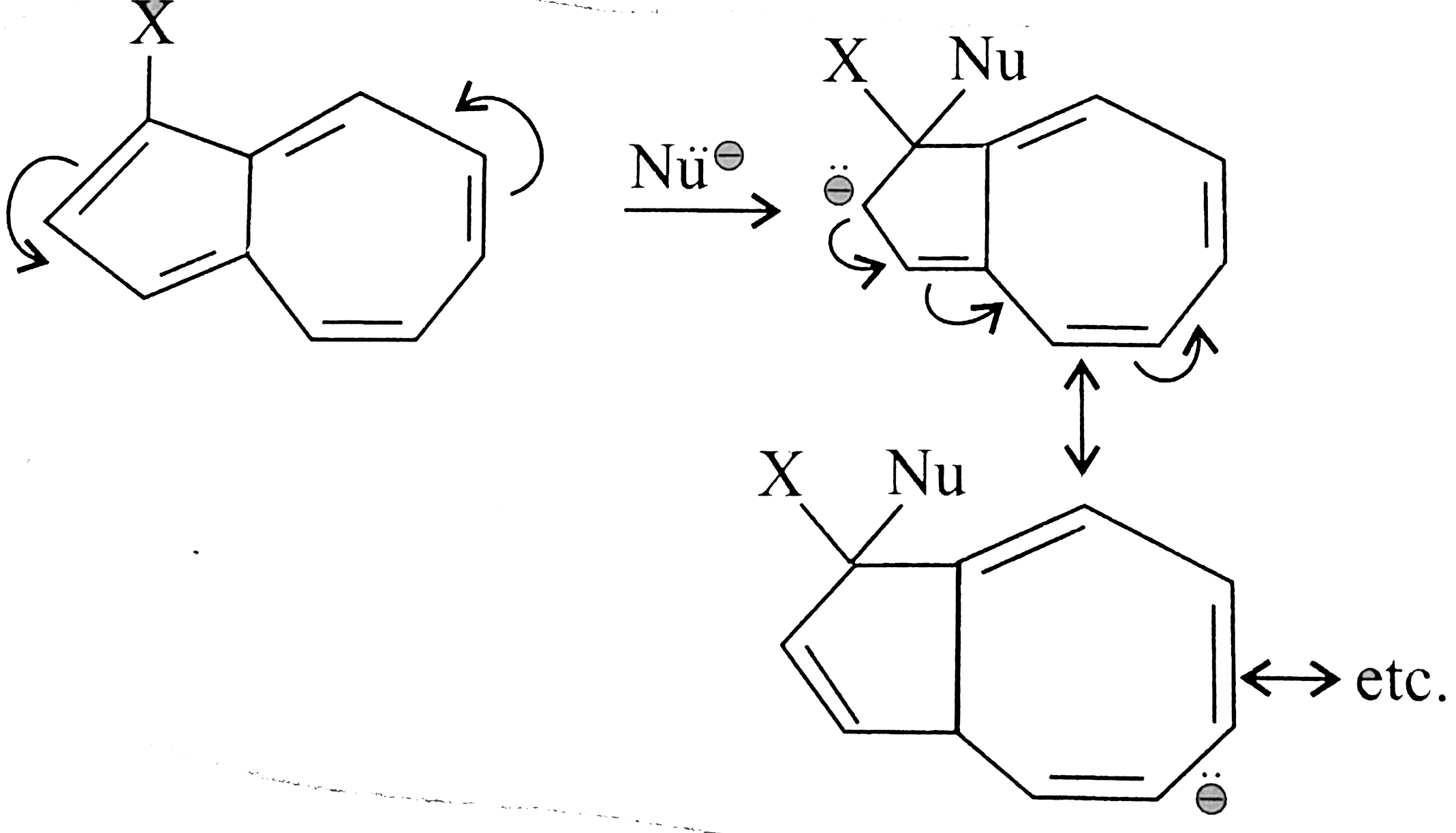(a)Azulene has an appreciabel dipole moment.Write the reasonance structure that explains the dipole moment and its aromaticity.
(b)In the cse of halogen-substituted azulenes,a halogen atom onC−6can be displace bynucleophile while one onC−1is unreactive towards nucleophile .Rationalise this differemce in behaviou.

The major contribution to the hybrid must be one that involves charge separation ,having aromatic five-and seven-membered rings.
(b)
ArSN intermediate reaction is favoured by five-membered ring woth cyclopentadienyl anion character(aromatic).
In the second case¯ediscoalisation into the other (seven-membered)ring result in eight¯e-in that ring ,which doesnot stablise it.
Topper's Solved these Questions
- AROMATIC COMPOUNDS AND ALKYL AND ARYL HALIDES BOOK - CENGAGE CHEMISTRY ENGLISHCHAPTER - AROMATIC COMPOUNDS AND ALKYL AND ARYL HALIDES EXERCISE - Solved Examples
21 Videos
- AROMATIC COMPOUNDS AND ALKYL AND ARYL HALIDES BOOK - CENGAGE CHEMISTRY ENGLISHCHAPTER - AROMATIC COMPOUNDS AND ALKYL AND ARYL HALIDES EXERCISE - Solved Problems
37 Videos
- APPENDIX INORGANIC VOLUME 2BOOK - CENGAGE CHEMISTRY ENGLISHCHAPTER - APPENDIX INORGANIC VOLUME 2EXERCISE - Short Answer Type
179 Videos
- BIOMOLECULESBOOK - CENGAGE CHEMISTRY ENGLISHCHAPTER - BIOMOLECULESEXERCISE - Exercises Archives (Analytical And Descriptive)
8 Videos
Similar Questions
Polar covalent molecules exhibit dipole moment. Dipole moment is equal to the product of charge separation , q and the bond length d for the bond. Unit of dipole moment is debye. One debye is equal to 10−18 esu cm.
Dipole moments is a vector quantity. It has both magnitude and direction. Hence, dipole moment of a molecule depends upon the relative orientation of the bond dipoles, but not on the polarity of bonds alone. A symmetrical structure shows zero dipole moment. Thus, dipole moment helps to predict the geometry of a molecules. Dipole moment values can be distinguish between cis- and trans- isomers, ortho, meta and pare-forms of a substance, etc.
Q. Which of the following statement is correct regarding C2H2F2 molecule?
View SolutionPolar covalent molecules exhibit dipole moment. Dipole moment is equal to the product of charge separation , q and the bond length d for the bond. Unit of dipole moment is debye. One debye is equal to 10−18 esu cm.
Dipole moments is a vector quantity. It has both magnitude and direction. Hence, dipole moment of a molecule depends upon the relative orientation of the bond dipoles, but not on the polarity of bonds alone. A symmetrical structure shows zero dipole moment. Thus, dipole moment helps to predict the geometry of a molecules. Dipole moment values can be distinguish between cis- and trans- isomers, ortho, meta and pare-forms of a substance, etc.
Q. A diatomic molecule has a dipole moment of 1.2D. If the bond length is 1.0×10−8 cm, what fraction of charge does exist each atom?
View Solution
Knowledge Check
Polar covalent molecules exhibit dipole moment. Dipole moment is equal to the product of charge separation , q and the bond length d for the bond. Unit of dipole moment is debye. One debye is equal to 10−18 esu cm.
Dipole moments is a vector quantity. It has both magnitude and direction. Hence, dipole moment of a molecule depends upon the relative orientation of the bond dipoles, but not on the polarity of bonds alone. A symmetrical structure shows zero dipole moment. Thus, dipole moment helps to predict the geometry of a molecules. Dipole moment values can be distinguish between cis- and trans- isomers, ortho, meta and pare-forms of a substance, etc.
Q. Which of the following statement is correct regarding C2H2F2 molecule?AOne isomer is polar, one is non-polarBTwo isomers are polar, one is non-polarCTwo isomers are planar, one is non-planarDTwo isomers are only possible and planarPolar covalent molecules exhibit dipole moment. Dipole moment is equal to the product of charge separation , q and the bond length d for the bond. Unit of dipole moment is debye. One debye is equal to 10−18 esu cm.
Dipole moments is a vector quantity. It has both magnitude and direction. Hence, dipole moment of a molecule depends upon the relative orientation of the bond dipoles, but not on the polarity of bonds alone. A symmetrical structure shows zero dipole moment. Thus, dipole moment helps to predict the geometry of a molecules. Dipole moment values can be distinguish between cis- and trans- isomers, ortho, meta and pare-forms of a substance, etc.
Q. Which of the following statement is correct regarding C2H2F2 molecule?AOne isomer is polar, one is non-polarBTwo isomers are polar, one is non-polarCTwo isomers are planar, one is non-planarDTwo isomers are only possible and planarAn organic reaction occurs through making and breaking of bonds. The breaking of bonds may occur either homolytically leading to the formation of radicals or heterolytically generating positively and negatively charged species. The neutral species (free radicals, carbenes, nitrenes, etc.) and positively charged species being electron deifcient are collectively called electrophiles while neutral and negatively charged species which are electron rich are called nucleophiles. An organic reaction usually involves the attack of a reagent (radicals, positively and negatively charged species) on the substrate molecule). The substrate molecule, although as a whole electrically neutral, has centres of low and high electron density due to displacement of bonding electrons. These electrons displacements occur through inductive, electromeric occur through inductive, electromeric, resonance and hyperconjugation effects. Whereas inductive effects involve displacement transfer of n-and π-electrons along a conjugated system. Hypercongation effects, on the other hand, involve σ−π-conjugation. Both inductive and hyperconjugation effects can be used to explain the stability of carbocations and free radicals which follow the stability order: 3∘>2∘>1∘. The stability of carbanions, however, follows opposite order.
The stability of a molecule can be judged on the basis of contribution of its resonance structures. Resonance structures have same position of nuclei and have same number of unpaired electrons. Among resonance structures, the one which has greater number of covalent bonds, has less separation of opposite Charges, a negative charge on more electronegative and a positive charge on a more electropostive atom are more stable than others.
The C-C bond length in propene s little shorter (1.49 Å) than the C-C bond length (1.54 Å) in ethane. This is due toA+I effect of CH3 groupBmesomeric effectCelectromeric effectDhyperconjugation effect
An organic reaction occurs through making and breaking of bonds. The breaking of bonds may occur either homolytically leading to the formation of radicals or heterolytically generating positively and negatively charged species. The neutral species (free radicals, carbenes, nitrenes, etc.) and positively charged species being electron deifcient are collectively called electrophiles while neutral and negatively charged species which are electron rich are called nucleophiles. An organic reaction usually involves the attack of a reagent (radicals, positively and negatively charged species) on the substrate molecule). The substrate molecule, although as a whole electrically neutral, has centres of low and high electron density due to displacement of bonding electrons. These electrons displacements occur through inductive, electromeric occur through inductive, electromeric, resonance and hyperconjugation effects. Whereas inductive effects involve displacement transfer of n-and π-electrons along a conjugated system. Hypercongation effects, on the other hand, involve σ−π-conjugation. Both inductive and hyperconjugation effects can be used to explain the stability of carbocations and free radicals which follow the stability order: 3∘>2∘>1∘. The stability of carbanions, however, follows opposite order.
The stability of a molecule can be judged on the basis of contribution of its resonance structures. Resonance structures have same position of nuclei and have same number of unpaired electrons. Among resonance structures, the one which has greater number of covalent bonds, has less separation of opposite Charges, a negative charge on more electronegative and a positive charge on a more electropostive atom are more stable than others.
What is the decreasing order of stability of the ions ?
I. CH3−+CH−CH3 II. CH3+CH−OCH3
III. CH3−+CH−COCH3
View SolutionAn organic reaction occurs through making and breaking of bonds. The breaking of bonds may occur either homolytically leading to the formation of radicals or heterolytically generating positively and negatively charged species. The neutral species (free radicals, carbenes, nitrenes, etc.) and positively charged species being electron deifcient are collectively called electrophiles while neutral and negatively charged species which are electron rich are called nucleophiles. An organic reaction usually involves the attack of a reagent (radicals, positively and negatively charged species) on the substrate molecule). The substrate molecule, although as a whole electrically neutral, has centres of low and high electron density due to displacement of bonding electrons. These electrons displacements occur through inductive, electromeric occur through inductive, electromeric, resonance and hyperconjugation effects. Whereas inductive effects involve displacement transfer of n-and π-electrons along a conjugated system. Hypercongation effects, on the other hand, involve σ−π-conjugation. Both inductive and hyperconjugation effects can be used to explain the stability of carbocations and free radicals which follow the stability order: 3∘>2∘>1∘. The stability of carbanions, however, follows opposite order.
The stability of a molecule can be judged on the basis of contribution of its resonance structures. Resonance structures have same position of nuclei and have same number of unpaired electrons. Among resonance structures, the one which has greater number of covalent bonds, has less separation of opposite Charges, a negative charge on more electronegative and a positive charge on a more electropostive atom are more stable than others.
The C-C bond length in propene s little shorter (1.49 Å) than the C-C bond length (1.54 Å) in ethane. This is due to
View SolutionPolar covalent molecules exhibit dipole moment. Dipole moment is equal to the product of charge separation , q and the bond length d for the bond. Unit of dipole moment is debye. One debye is equal to 10−18 esu cm.
Dipole moments is a vector quantity. It has both magnitude and direction. Hence, dipole moment of a molecule depends upon the relative orientation of the bond dipoles, but not on the polarity of bonds alone. A symmetrical structure shows zero dipole moment. Thus, dipole moment helps to predict the geometry of a molecules. Dipole moment values can be distinguish between cis- and trans- isomers, ortho, meta and pare-forms of a substance, etc.
Q. A diatomic molecule has a dipole moment of 1.2D. If the bond length is 1.0×10−8 cm, what fraction of charge does exist each atom?
View SolutionChemical bonding between two atoms is necessarily with an electrical moment arising out of the difference in electronegativity of two atoms. This means that every bond carries with it an electrical moment called the bond moment.The dipole moment of a molecule is really the vectorial sum of the individual bond moment present in it. To compute the dipole moment it is necessary to find out the values of various bond moment in the moment of different bonds are as given.
Bond−−−−−→H−C −−−−−→C−Cl −−−−−→C=OBond moments0.4D 1.5D 2.5D
The group moments of few groups as given
GroupNO2OHCNCH3direction of dipoletoward Ntowards Otowards Naway fromCH2Dipole moment4D1.6D3.8D0.4D
The bond angle in H2S is 97∘ and its dipole moments is 1.5 D.The S-H bond distance is 0.15 nm.There fore approximate percentage ionic character of S-H bond is (neglect the effect of dipole moment of lone pair on sulphur atom in H2S).(Given [cos 97∘=−0.12] and √0.88=0.94)
View SolutionChemical bonding between two atoms is necessarily with an electrical moment arising out of the difference in electronegativity of two atoms. This means that every bond carries with it an electrical moment called the bond moment.The dipole moment of a molecule is really the vectorial sum of the individual bond moment present in it. To compute the dipole moment it is necessary to find out the values of various bond moment in the moment of different bonds are as given.
Bond−−−−−→H−C −−−−−→C−Cl −−−−−→C=OBond moments0.4D 1.5D 2.5D
The group moments of few groups as given
GroupNO2OHCNCH3direction of dipoletoward Ntowards Otowards Naway fromCH2Dipole moment4D1.6D3.8D0.4D
In CH3CCl3(I),CHCl3(II) and CH3Cl(III) the normal tetrahedral bond angle is maintained.Also give cos 70.5∘=13 Therefore dipole moments of the given compounds are (given due to -I effect of Cl, the Bond moment of H-C bond directed toward the H in CHCl3)
View Solution
